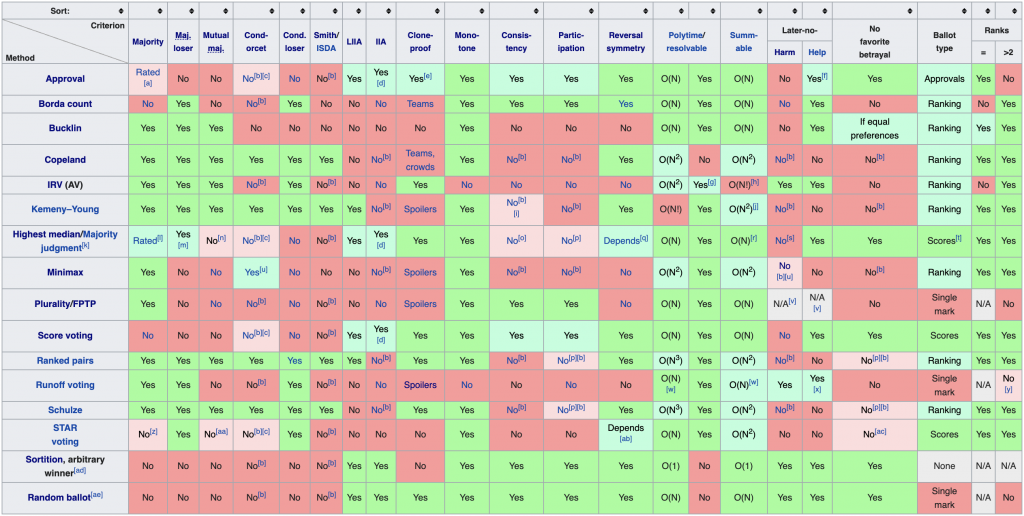
Is There Even A Good One? Matching Voting Systems With Logical Requirements
I recently discovered that voting systems are an intriguing field to study. In everyday life we often encounter situations in which a vote takes place, e.g., when agreeing on which movie to watch, which restaurant to dine at in a group, or when electing government officials. There are a number of different ways in which such voting can be carried out. For example by letting every movie evening attendee name their absolute favorite, and watching the movie with the most support.
This seemingly simple plurality voting has an important shortcoming: Suppose there are three movies, two of which are action movies and one is a horror movie. The votes might be split between the two action movies leading to the horror movie winning, even though the majority of voters would have preferred either of the two action movies over the horror movie.
The example illustrates that a voting system can fail in certain situations, where one would want it to have a different outcome in order to be considered good. What is good though? More systematically, one can specify voting system evaluation criteria. Such criteria exist in large numbers just like voting systems do. The intriguing circumstance is that one can define a number of seemingly sensible evaluation criteria and will find that there is no voting system which satisfies all of them.

This article examines a small subset of this table. It first explains a handful of voting system evaluation criteria that – when looked at in isolation – seem perfectly reasonable. In a second step, it shows that a number of voting systems violate at least one of the criteria. The intention is to spark the reader’s interest and make the topic more accessible than it is through the large table on Wikipedia.
The source for this collation is the Wikipedia article with the large table and the Wikipedia articles it references. The contribution here is the summarization and selection of the topics.
Evaluation Criteria
The majority criterion (wiki) states that if there is a candidate who has the majority of the voters supporting them, this candidate must win.
For example in a political election there might be three parties, party A is the first choice of 60% of the voters. A voting system satisfying the majority criterion would have party A win the election. This criterion is very intuitive and probably seems fair.
Related is the majority loser criterion (wiki) which states that if a majority of voters prefers every other candidate over a given candidate, then that candidate must not win.
For example, three candidates can be voted for, let’s call them A, B, and C. 60% of the voters prefer B and C over A, that is, they vote by saying either C > B > A or B > C > A. If the majority loser criterion holds, A cannot win the election. Note that for this criterion the voters must express their preference as an ordering of the candidates, not just a single choice. The movie evening example brought up at the beginning would be in conflict with this criterion. Recall, there were two movies that the majority of people preferred over the third movie. When voting by majority, the third movie can win.
The Condorcet criterion (wiki) is fulfilled if a candidate wins who would beat all other candidates in two-candidate elections. Note that there is not always such a candidate.
Consider this example: Four candidates are in the race, A, B, C, and D; voters have their preferences. Candidate B would win against A, if they were the only two candidates. Likewise, candidate B would win against C and D in a heads-up competition. If a candidate like B exists, the candidate must win the vote, according to the Condorcet criterion.
A voting system is consistent (wiki) if, whenever the electorate is divided (arbitrarily) into several parts and elections in those parts garner the same result, then an election of the entire electorate also garners that result.
Coming back to the movie evening example this would mean the group splits and the groups decide independently which movie to watch. All groups proceed according to the same voting system. If they happen to end up with the same choice, a vote in the entire group has to yield the same result, according to the consistency criterion.
Voting Systems
In approval voting (wiki) every voter gets the list of candidates and assigns either a Yes or a No to each of them. The winning candidate is the one with the most Yes votes. In other words, voters decide for every single candidate whether they approve of them. The candidate with the most approvals wins.

Plurality voting (wiki) is a form of voting, where every voter has to decide for exactly one candidate. The candidate with the most supporters wins.
In political settings, this voting system is known to converge to a two-party constellation, as explained in this highly recommended video by CGP Grey.
With the random ballot (wiki) method a single voter is randomly selected out of the pool of all voters. The election outcome is that particular, randomly selected voter’s preference. This could be a popular choice or a niche party. Intuitively, this method has interesting properties such as also allowing minorities to exercise power at least sometimes.
Consider for example a case where students disagree on whether the lunch break should last 60 or 30 minutes. Suppose 70% favor the longer break, with all of the voting systems above the break is always 60 minutes long. With the random ballot method, the break would be 60 minutes long at 70% of the days and just 30 minutes at the remaining days. That way the minority of short-break-favoring students does not get overruled every time.
Instant-runoff voting (wiki) is the most sophisticated voting method in this collection. It requires every voter to order the candidates by preference. Suppose there are three candidates, A, B, and C; a voter might submit a ballot which says “First choice A, second choice C, third choice B”. In order to determine a winner, one checks whether there is any such candidate who is the first choice among the majority of voters. If there is none, the candidate who is the first choice in the fewest cases gets removed from all ballots and the evaluation starts anew (without voters casting new votes).
This method has an important advantage over the plurality voting, which is best explained using an example. Let’s get back to the movie evening in greater detail. Possible options might be (A) James Bond, (B) Tenet, and (C) Blair Witch Project. Six of the eleven attendees like action movies and distribute their votes across A and B, resulting in C having the remaining horror movie enthusiasts (five, to be specific). With plurality voting the horror movie would win, it has received the most votes. However, with instant-runoff voting either A or B would get kicked out of the race first and the votes of all six people who voted for A or B would now support the single remaining of the two movies. After that first iteration, instant-runoff voting would result in the action movie winning. That seems intuitively more fair, because vote-splitting (here between the two action movies) does not cause the less preferred option to win.
Matching
Next, we evaluate the four listed voting methods against the evaluation criteria specified above. The table shows the results: Green cells indicate that the respective voting method (row) matches the evaluation criterion (column). Red cells indicate that the criterion is being violated.
| Majority criterion | Majority loser criterion | Condorcet criterion | Consistency criterion | |
|---|---|---|---|---|
| Approval voting | No | No | No | Yes |
| Plurality voting | Yes | No | No | Yes |
| Random ballot voting | No | No | No | Yes |
| Instant-runoff voting | Yes | Yes | No | No |
It is immediately apparent that there is not a single voting system which satisfies all criteria. In fact, all of them violate at least half of the criteria. Let’s look at some of the table’s cells in more detail:
Approval voting violates the majority criterion because a candidate with more than 50% approval is not necessarily the winner. There could be a candidate with even more approval. This violation does not seem problematic.
More complicated: Why does the plurality voting violate the Condorcet criterion? Remember the Condorcet criterion says that a candidate must win if they would beat all other candidates in one-against-one elections. Consider this scenario: There are three candidates, A, B, and C. Suppose the voters could be divided into three groups: 40% of the voters prefer A the most, followed by B, and lastly C. Their ordering is ABC. Let’s refer to this group as G1. 45% of the voters rank the candidates as CAB; the group called G2. The remaining 15% prefer BAC; G3. With plurality voting, candidate C would win with 45% of the votes (A has only 40% and B 15%). If there were only A and B in the race, however, A would win with support of G1 and G3, resulting in a total of 55% of the votes. If only A and C were possible candidates, again candidate A would win with support of G1 and G2 (85%). It is apparent that candidate A would win in any one-against-one election. According to the Condorcet criterion they would have to win the election, but they don’t because B wins.
Even more complicated: Instant-runoff voting violates the consistency criterion. A detailed example is outlined here.
Conclusion
Voting systems are an intriguing topic. There’s more behind them than one might think at first glance. In everyday-life situations one might accidentally overlook the implications of a chosen voting system for decision making. A practical advice is to go with approval voting rather than plurality voting to avoid vote splitting. If the audience is receptive to the complexity of the topic, one can also suggest instant-runoff voting as the probably “fairest” system among the ones presented. I have added the random ballot voting to the list of voting systems because it is unusual and reminds one that a usual voting system can totally overrule minorities! That is something to keep in mind.
I hope this article sparked the interest of some readers who I would refer to the aforementioned Wikipedia page for further exploration. The featured image on top shows me in the empty German Bundestag. The German voting system is by the way a very sophisticated one (in a good sense) whose main shortcoming is unfortunately – as my social studies teacher used to say – its complexity.